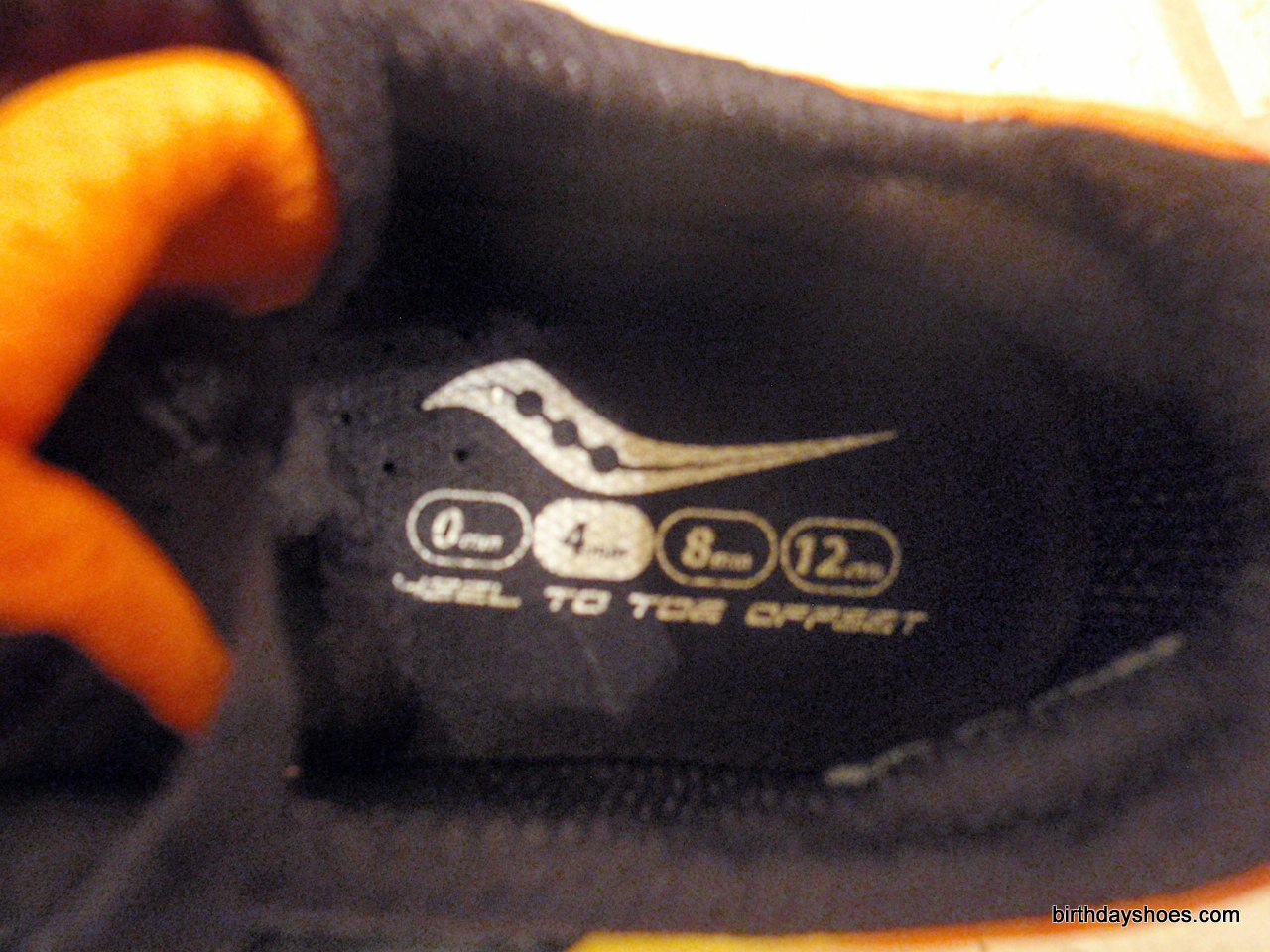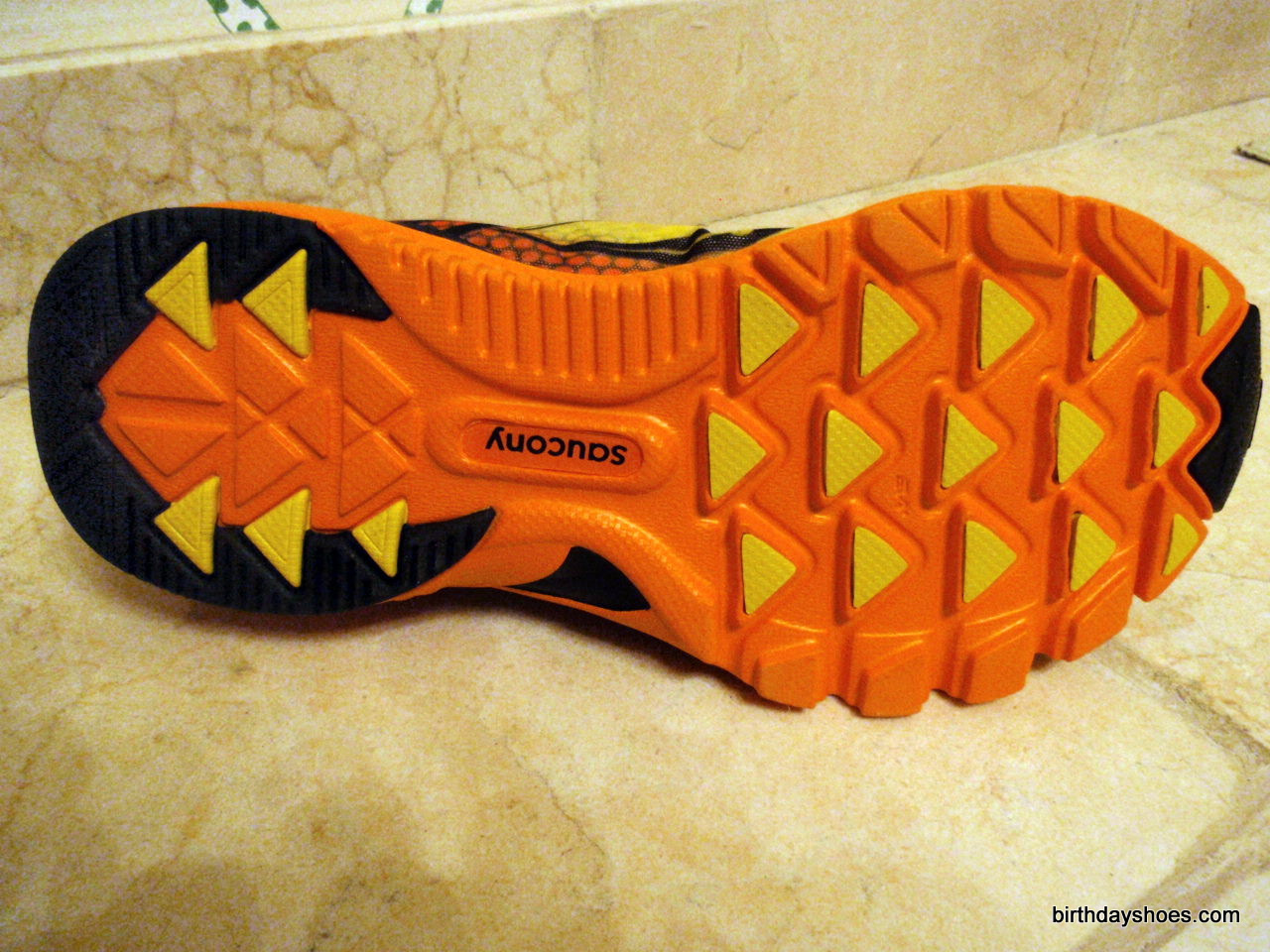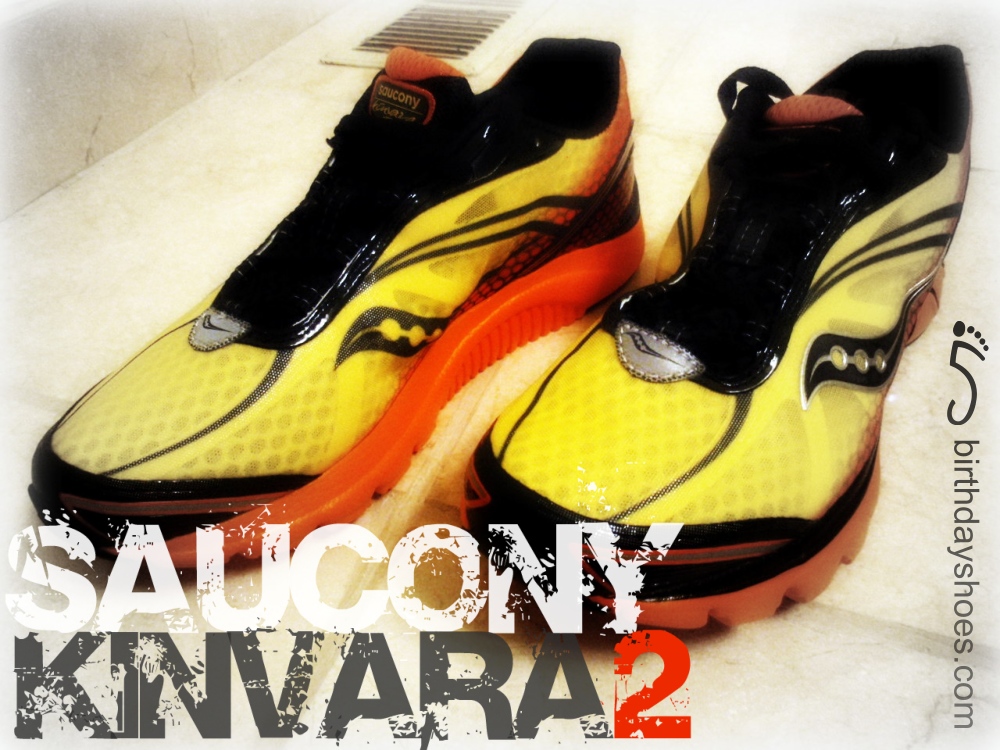We understand that the Saucony Kinvara 2™ has been out for quite a while and as of this writing
the Kinvara 3™ has just recently hit the stores. Actually, due to the release of the Kinvara 3,
you can pick up the Kinvara 2 on the cheap right now.
So why a Kinvara 2 review if it’s old news? For one, the Kinvara 2 has been a popular shoe for minimalist-minded runners ever since it’s release (and not unlike the original Kinvara), so reviewing it is a way to make sure BirthdayShoes readers are kept in the know of what’s hot (or not).
Two, as this will be the first Kinvara review for
BirthdayShoes, it serves the (future) purpose of comparing the Kinvara 2 to the Kinvara 3 as well as possible future shoes in the same line. Plus I’d just happened to be using the Kinvara 2 quite a bit over the past several weeks.
So allow me to jump right in … after the jump!
Overview
Some of the
pros of this shoe to me were:
- Low heel-to-toe drop: 4mm
- Lightweight: 7.3oz (M9)
- Low stack height: Heel (23mm), Forefoot (19mm)
- Secure fit in the heel
- Works with either my Montrail Enduro Sole™ or SuperFeet Black™ insoles
- Sock fit was very soft and running sockless felt great
Some of the
cons with this shoe:
- Toe box is too narrow if you use your normal running shoe size (wide is available or go half size up)
- Not sure the thin upper material will hold up to a lot of mileage and flexing
- Midsole is a bit stiff
Overall I’d give the Saucony Kinvara 2 high marks and definitely would be interested in owning another pair. Do to the lack of toe room in the pair I have I’d probably limit how far I’d run in them. However, I did manage to eke out a bit more toe room by running sockless so that is always an option. The 4mm drop seems about right; I could easily maintain my midfoot (or full foot) strike without any problems.
The Upper

The Saucony Kinvara 2 utilizes a fairly simple, sock fit style upper constructed with a mono-filament outer mesh and a plush sock liner on the inside of the upper. I found the sock liner to be extremely comfortable with or without socks.
The all mesh upper was extremely breathable, nice on the hot weather I’ve been running in lately here in the Deep South. However, I was a bit concerned that after heavy use this all mesh style of upper would begin to tear at the metatarsal flex point as has every shoe I’ve ever owned that was constructed similarly. The only way to mitigate this issue is to reinforce the mesh with a band of tougher material right where the upper joins the midsole.
The heel cup was very nice, soft and very securely held my heel in place even with using my typical orthotic insoles (Montrail Enduro Sole or SuperFeet Black).
Probably my biggest issue with this shoe was that the toe box is rather pointed and lacks adequate room for proper toe spread. For somebody interested in the Kinvara 2 I’d recommend going up half a size. I also know the Kinvara 2 is available in a wide so perhaps that’s another option. Because of the lack of toe room I’d be hesitant to go more than 15-20 miles at a time in them for fear of issues related to constraining proper toe spread (for me that means between the toe blisters, black toe nails, etc…). However, for everyday mileage this is a great shoe. I even found I could buy a little more toe room by simply running sockless (something I’ve rarely done outside of wearing
Vibram Five Fingers).
The Midsole
I found the midsole to be very nice and firm; comparable to
the Altra Provision I recently reviewed but perhaps a touch cushier. The 4mm heel-to-toe drop feels very right for this shoe as I was able to easily maintain a full-midfoot strike.
My only complaint with the midsole is that I wish it were a bit more flexible. While the midsole is not crazy stiff I think it would make for a softer foot strike transition and more dynamically responsive shoe if it were more flexible.
The Outsole

I felt the tread of this shoe was pretty good overall; no traction issues on any the surfaces I tested on; gravel, asphalt, concrete and some light trail use. In fact I’d almost consider this to be a hybrid road-trail shoe as the tread is likely aggressive enough for just about any dry trail and certainly for any gravel or 4×4 roads you’d encounter. However, I wouldn’t recommend running on more technical or wet and muddy trails.
My only concerns with the outsole are how long it will hold up to wear. I still wonder why the most high abrasion rubber re-enforcement is only in the heel and extreme front end of the toe areas when this shoe is clearly designed for mid-foot striking? While there are other rubber sections in the mid-fore foot area this material seems lighter and less abrasion resistant than the other areas I described (heel and extreme front end). I think a better design choice would be to use more of the high friction rubber along the typical mid-fore foot strike pattern wear areas. On the other hand, from what I’ve been reading, it seems like most folks are getting typical shoe mileages out of the Kinvara 2 so perhaps this is a non-issue?
Function
As of this review I have tested the Saucony Kinvara 2 by running over 60 miles on mostly paved and gravel roads and paths with some dry single track trail. My longest run was 14 miles that was mostly a mix of hilly gravel roads and flat asphalt bike path.
On all of these surfaces this shoe performed as designed and functioned well. I felt this shoe had plenty of traction everywhere I used it. While I was initially concerned about the lack of high friction rubber in the outsole where the main foot strike areas are after 60 miles I could hardly notice any significant wear.
The overall cushioning felt great and was just enough to protect my feet from the large gravel chunks I frequently ran over; however the midsole could be a bit more flexible.
The upper was extremely breathable and a real treat running in the hot and humid afternoons around here. Not sure about the overall durability of an all mesh upper but over the mileage I ran I could detect no significant wear. The biggest issue was the tight and pointy toe box. Felt very cramped with orthotic use coupled with wearing medium thickness running socks. Was endurable when I ran sockless and with my more minimal orthotic insole.
Really like this shoe for typical week day training run mileage on asphalt to easier non-technical trails.
Conclusion
I really like this shoe and would definitely recommend it to others and would buy another pair myself. However the shoe could be tweaked and I’m anxious to try the Kinvara 3 to see if any of my recommendations have been addressed that are namely:
- Toe box needs to be less pointed and have a bit more room; anatomical shaping would be highly preferential.
- Midsole could stand to be a bit more flexible, perhaps by reducing the overall stack height a touch could accomplish this.
- Outsole needs to use more of the high friction rubber in the predicted mid-fore foot strike areas; would most likely significantly increase the life of the shoe.


9 replies on “Saucony Kinvara 2 Running Shoes Review”
Good review. I had the kinvara 1 and have a newly delivered pair of the 3’s waiting for me at home right now. Toe box room was my big issue with the first one, and it sounds like it was not addressed in this version. But I have read it has been improved in the 3. Also, the 3, unlike the earlier models, is available in a 2E width. Seems to me they are making really good strides with an already very solid shoe.
“Low stack height: Heel (23mm), Forefoot (19mm)”
Come on, are you kidding?
That’s not low in my book, and since this is a website about ‘barefootstyle’ shoes I guess most people here do not considder that as a low stack hight.
This shoe has a narrow, pointy toebox and a stiff cushioned non zero drop sole… and it still gets recommended.
I respect the reviewer, but I can’t help but feel that his reviews are out of place for this website.
@Frunning,
Rob’s made it pretty clear where he’s coming from — which is the perspective of a runner with thousands of miles under his feet running trails and training for ultramarathons. His perspective is that running form is what’s most important and that there can be a time and a place for cushioned soles.
While that isn’t the prevailing paradigm of this site or a primary quality of most shoes reviewed and talked about here, it’s an important paradigm. In particular, it’s important to consider what’s most important to run without injury. And that’s arguably a light, low-impact form — landing on the ball of your foot. A barefoot style shoe isn’t a prerequisite to having good form though for many of us, it’s what works, it’s the best way to keep our form in check (perhaps next to running barefoot), etc.
But what I want to avoid on this site is a dogmatic view of running that there’s just one true way — heck, if we wanted to take that perspective, we’d just say running *actually* barefoot is the one true path and anything on your feet is a bad idea.
The truth is more complex — as is usually the case. And what I appreciate about Rob’s view on this site is that it challenges some of the dogmatic tendencies we have in the minimalist shoe community that there’s some black and white solution for running.
So to the extent that Rob’s reviews and perspective remind us that ultimately it’s about the runner (and not the shoes), well, I think that’s a good thing. The last thing I want is this site to be exclusively a choir that rallies around one view at the exclusion of anything that challenges that view.
Hope that helps elucidate why a review on a shoe that isn’t barefootstyle — and I think Rob would fully agree with that as I would — would show up on a site like BirthdayShoes.
Hopefully that makes some sense of it. Let me know if I’m just clear as mud!
@ Justin: hear hear. Within the past year I’ve run in everything from the brooks adrenaline and Nike Vomero to totally barefoot and most everything in between. I’m also a dedicated and active member of this site. There are a lot of good choices out there, and what’s a good choice isn’t the same thing for every person. Barefoot running isn’t a religion and this isn’t a holy war.
IMO the Vinvara and Nike free have done more to raise the profile of and discussion regarding running form and footwear than even vibrams. No, they aren’t true minimalist shoes (let alone “barefoot” shoes, whatever that is), but it can be exactly what some people want/need. Pete Larson, “runblogger” and the author of a new book about this stuff, loves the Kinvara. And he knows a bit about form and footwear.
There’s no reason to knock the Kinvara – for what it is, it’s excellent. Now, you may not want what it is, and that’s fine. This site has done countless reviews of more minimal shoes and made clear what those shoes are all about and their own relative strengths and weaknesses. All so we can all choose what’s best for ourselves. There’s no reason for dogma here.
Good review, thanks!
I am actually looking for some shoes which are not too minimalistic but enough, due to the fact that after a few weeks of training with VFFs I can’t use my archilles tendon anymore 😉
Maybe these will do. I’ll look into it.
@Frunning
Justin already covered most of what I would have said (and then some) in his response to your comment. I’ve been on vacation for the past month so was not able to respond to comments before now.
Anyhow, I’d just add that I recommended the Kinvara despite it’s detractors, such as the pointy and narrow toe box and stiff and not very flexible midsole-outsole, because I believe the positives of this line of shoes far outweigh the detractors. This is a great shoe for those of us who desire a fairly lightweight and low heel-to-toe drop shoe but don’t want to sacrifice underfoot protection (i.e. want ample cushioning). If you read my review then you know that I felt the toe box was adequate when I ran sockless although I’d recommend sizing up a half size in the Kinvara2 for more toe room.
I hope to review the Kinvara 3 very soon so stay tuned…
Thanks for the review. I love this shoe. I bought it on a whim when I found it on deep discount. But it’s quickly becoming a favorite.
I just wanted to add that I live in Boulder CO and I’ve used the shoe on some VERY technical terrain and from a traction standpoint, I’ve had no problems at all. Even on high-speed (for me) technical descents it’s done well. It does lack the protection of a proper trail shoe. After a while, my feet get sore on highly technical terrain, but it’s fine up to about 1.5-2 hours for me. I’m planning to do a non-technical trail 50 in them this weekend. Unless it rains in which case I’m scrambling for a plan b. I too have concerns about them in wet and muddy conditions (which is incidentally how I found your review).
Hope that’s helpful to someone.
I don’t think that this website is the place to review this type of running shoe. What happened to Birthdayshoes, the fan website for minimalist footwear. This shoe might be considered “minimalist” by Saucony, but it’s NOT.
How can you run with those shoes having such a narrow toe box. It’ll give you lots of blisters!
@Tony,
I think it’s pretty clear why shoes like this are reviewed on this site — not only b/c minimalist-shoe using runners are running in them (which doesn’t make them minimalist) but also because it’s important to keep perspective on what’s minimalist, why use minimalist, and how other runners might NOT use minimalist for whatever reason, not the least of which is because they can run without injury in thicker shoes.
In other words, I think it’s useful to keep an open mind. What is or isn’t minimalist is answered in shades of grey. So having stuff like this on the site helps keep in mind that things aren’t black and white.